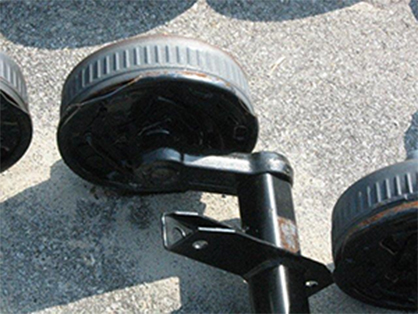paykwik al
online sportwetten
paykasa
paykwik
online sportwetten
paykasa
Trailer Suspension- How it Affects Your Safety
 By: EquiSpirit Trailer Company- Tom’s Trailer Talk
By: EquiSpirit Trailer Company- Tom’s Trailer Talk
This Month’s Trailer Talk is About- SUSPENSION
You probably don’t know how your trailer suspension works. It’s okay. No reason you should. You just need to grasp how it affects your safety. Here’s what you need to know:
QUICK TIPS
- You have rubber torsion suspension. How do I know? Because it’s on 99.9 percent of all horse trailers. To be sure, look between the tires. If you don’t see anything (springs and shackles), you have Rubber Torsion Suspension.
- It is an independent suspension. Each wheel supports the trailer independently of the others.
- You can drive a short distance with a flat tire. The trailer will remain stable and level, but the adjacent tire will be overloaded – drive cautiously.
- Rubber torsion absorbs the shock of the road. Your horses get a much smoother ride.
- The warranty is probably five years. The axles will most likely outlive the trailer.
- Rubber torsion axles are free of springs and shackles so they require less maintenance other than regular maintenance of bearings and brakes. If the axle gets bent from hitting something, you need to replace it. Uneven tire wear can be a sign of a bent axle. The other reasons for uneven tire wear are improper inflation and/or a defective tire.
- The axles can be blocked up. This will raise the trailer four inches. Goosenecks before 2000 might not clear today’s taller truck beds and still be level. Blocking the axles will help.
- Axles have a weight rating stating the weight limit they can sustain. Two 3500 axles will hold 7000 lbs. safely. Two 5200 lb. axles will sustain 10400 lbs. safely. Most manufacturers determine the GVWR (Gross Vehicle Weight Rating) (see our article, “Important Terms to Know“) of a trailer by the weight rating of the axles. A trailer with a GVWR of 7000 lbs. has two 3500 lbs. axles.
- Goosenecks are supported by a third axle – your truck axle. It supports 20% to 25% of the weight of the trailer. Factor this in when adding up weight on the axles.
- Rubber torsion axles work well with drive-on jacks such as TrailerAide.
- A trailer has to be level. The weight of the trailer has to be evenly spread across both axles and all four tires. Rubber torsion responds quickly to raising and lowering the trailer. Lifting the nose up puts more weight on the rear axle and vice versa.
Visit our website to read more Quick Tips!










